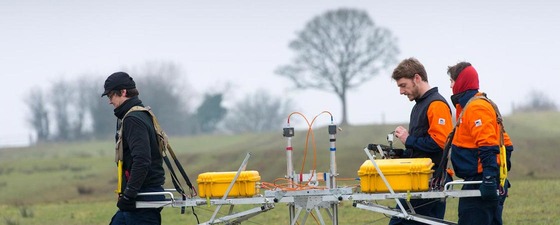In the 1980s, Dr. Colin Stove, a researcher at the University of Aberdeen, Scotland, UK, was working on a project run in conjunction with the European Space Agency. Synthetic Aperture Radar signals (SAR) recorded from an aircraft flying above a beach near Aberdeen showed penetration of the signals to depths of several meters rather than the centimeters expected by theory. Similar results were later seen in the Sahara Desert on radar imagery from an instrument carried aboard a Space Shuttle.
Dr. Stove went on to establish a Ground Penetrating Radar (GPR) business. As many geoscientists will know, this technology uses high frequency electromagnetic energy (EM, or radio waves) in the microwave band (gigahertz range) to make images of the shallow subsurface by measuring energy reflections. Penetration depends on the frequencies used for the signal, but even at the lower frequency range, GPR cannot penetrate more than a few tens of meters. Thinking back to the surprising results of the earlier airborne radar work, Dr. Stove believed it would be possible to extend the depth of penetration of ground-borne EM methods, but still using high frequencies to maintain high resolution.
He moved out of GPR and started researching how these technology enhancements could be made. They turned out to be similar to the techniques used for lasers, but in the microwave band (with devices sometimes called masers). Lasers produce EM waves in the visible range as a coherent monochromatic light that does not attenuate significantly over large distances. Masers produce coherent energy at microwave frequencies. When directed at materials such as rocks, at the frequencies used, Dr. Stove determined that the returning signals measured the dielectric properties of a rock and that they could be used to distinguish various rock types and also possibly low dielectric values as seen in hydrocarbons and coals.
Atomic Dielectric Resonance
In the mid-2000s, he formed a commercial company, Adrok, to implement the technology. The name of the company comes from Atomic Dielectric Resonance, ADR, the excitation set up inside the atoms of materials stimulated by the maser sources used for the technology. Dr. Stove’s son, Gordon, followed in his father’s footsteps and is now Managing Director of the company.
Dr. Stove’s objectives were to make measurements at much greater depths than GPR, up to the kilometers needed in hydrocarbon exploration. ADR techniques had already been used in the medical industry for very shallow tissue investigation. But ADR also uses higher frequencies than GPR, so how could it beat the tens of meters depth that were the best that GPR could manage?
The answer seems to be in the maser-like nature of the source, together with other enhancements, as Gordon Stove explains: “We send a directional beam of multiple radio frequencies into the ground at very low power,” he says. “The beam is continually pulsing and has resonant waves inside a large carrier wave that acts as a standing wave… By using low power and a directional, coherent beam, Adrok has overcome attenuation issues.” The beams are also focused. “Our beams are set up to triangulate to a focal point in the ground, converging with depth, unlike other geophysical techniques where the signal is omnidirectional and widens with depth.”
Early tests of the technology in Scotland indicated that hundreds of meters of penetration should be possible. One thing that is necessary with the technique is that the measured signals are calibrated against known boreholes. As different rocks give distinctive signals that can change depending on, for instance, cementation or pore fluids, profiles are first measured at existing well sites before moving on to undrilled locations. Signals measured from cores on site or in the lab can improve the calibration. Further tests for BG Group onshore UK indicated there is potential to detect coals for coal bed methane (CBM) or organic materials in shales.
Accurate Predictions
Adrok has also conducted surveys in other countries. In a survey of wildcat locations in Morocco conducted for Caithness Petroleum, ‘blind’ predictions made by the company using these techniques appeared to be more accurate than the prognosis for gas made by conventional seismic-based techniques. Robert Kennedy of Caithness says: “Adrok carried out ADR surveys on four locations where (we) knew the results but Adrok did not. They successfully identified stratigraphy and gas-bearing zones within 1.5m depth of each well. Over an undrilled prospect (they) identified seven gas zones at depths between 500m and 700m, to within a meter of forecast depth.”
Other Caithness results indicate the possibility of mapping stratigraphy to depths of 4,000m. In a well drilled by Caithness’ American partners onshore USA, where gas-bearing sandstones were expected at about 2,300m, Kennedy says “a commercial gas discovery was made at a depth within 0.3% of the Adrok forecast”.
Adrok has carried out surveys in many other locations and is working on implementing the technology offshore.






